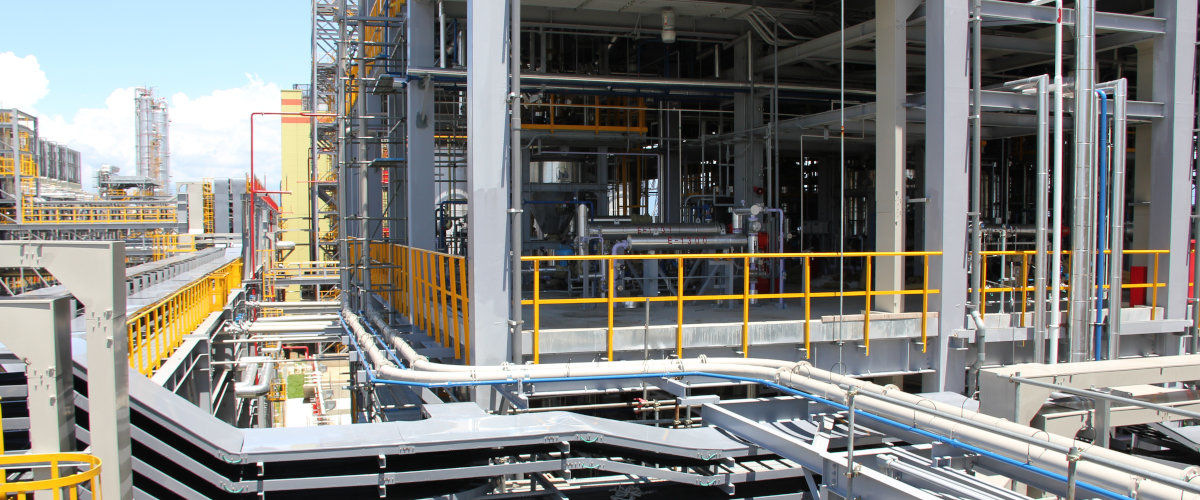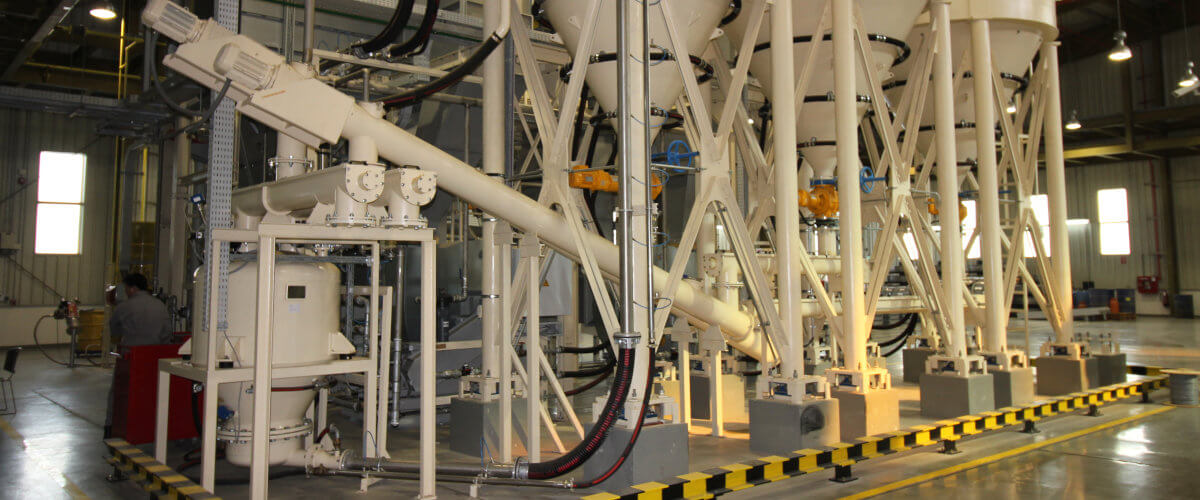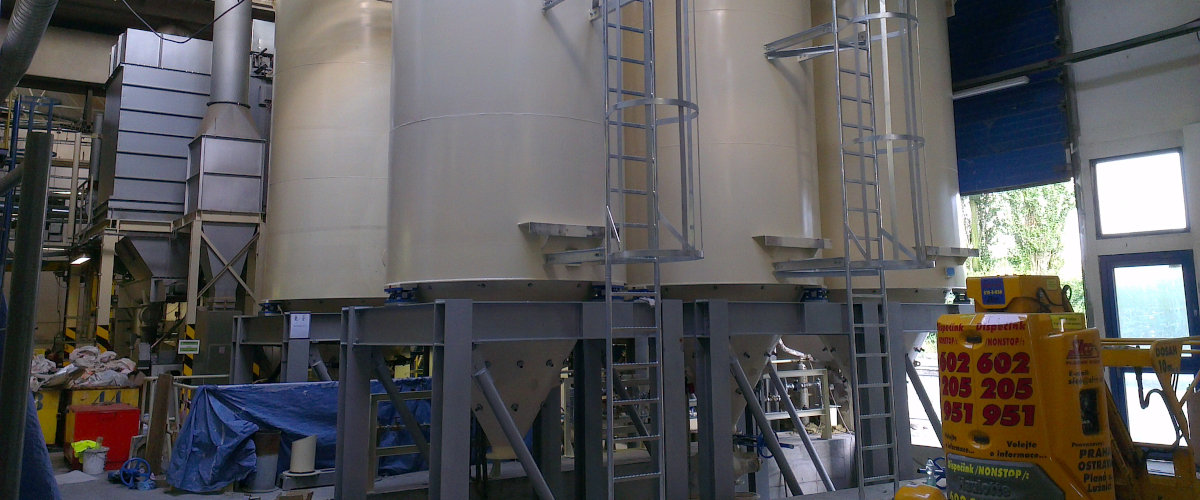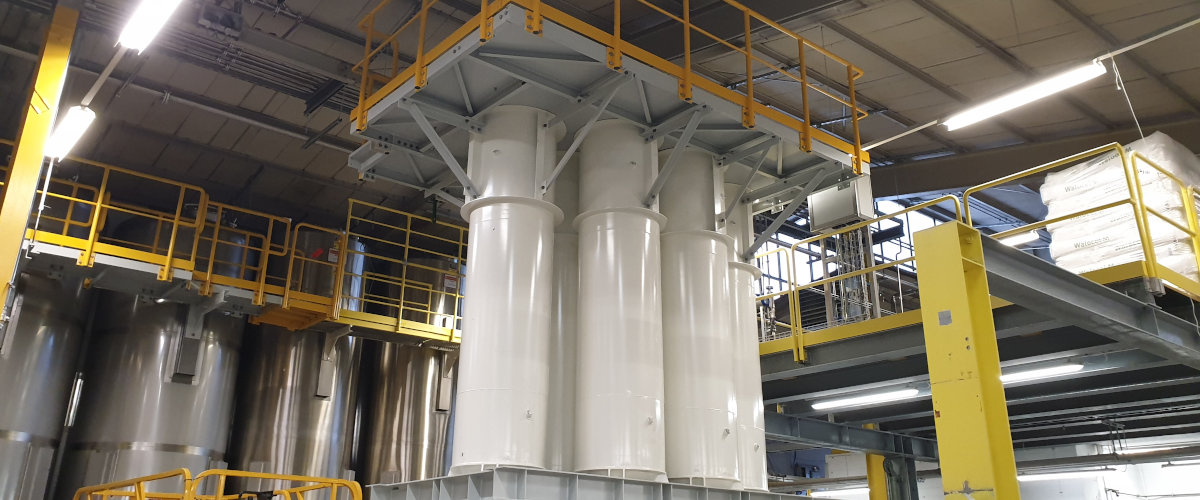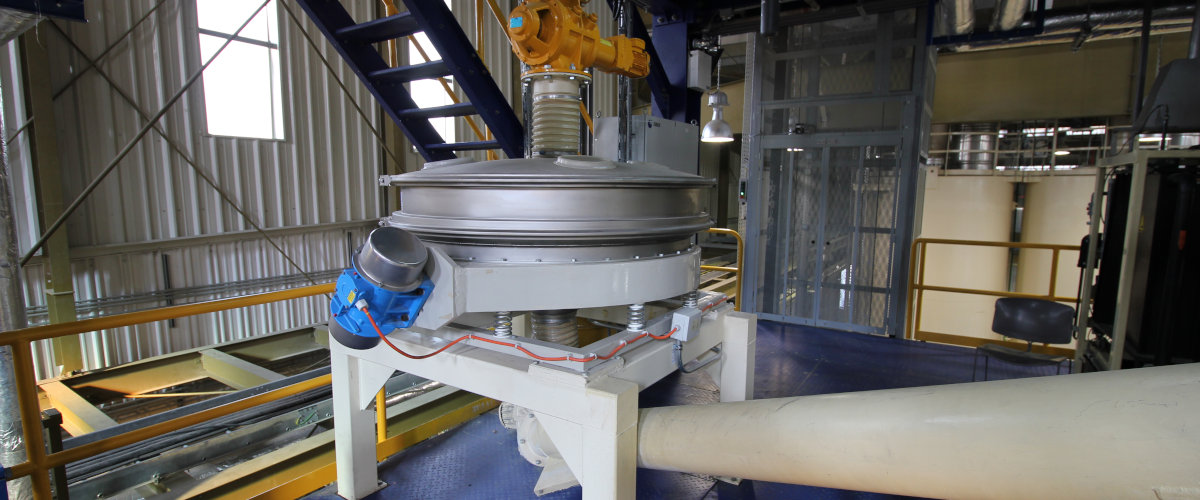Pneumatic Conveying Systems: Save Costs Through Proper Selection
For over 100 years, pneumatic conveying systems have been used in material handling to transport both bulk goods and piece goods, continually evolving over time.
The demands on a suitable pneumatic conveying system from the industry are high. The product must do more than simply move from point A to point B. Issues such as wear and tear, maintaining the grain structure, preventing material segregation, and preserving product attributes during transport must be addressed. At the same time, in the face of rising energy costs, particular attention must be paid to the economic efficiency of the conveying systems.
Engineers at Ingtec AG, formerly known as Rotzinger Pneumacon AG, are therefore engaged in the technology of various pneumatic conveying systems.
Do you have any questions for us, or would you like a personal consultation? Feel free to contact us via phone or email with no obligation.
What Types of Conveying Methods Are There?
Generally, the distinction is made between low-pressure and dense-phase conveying systems. Low-pressure conveying systems are known as dilute-phase systems.
Overview of Pneumatic Conveying/Conveying Systems:
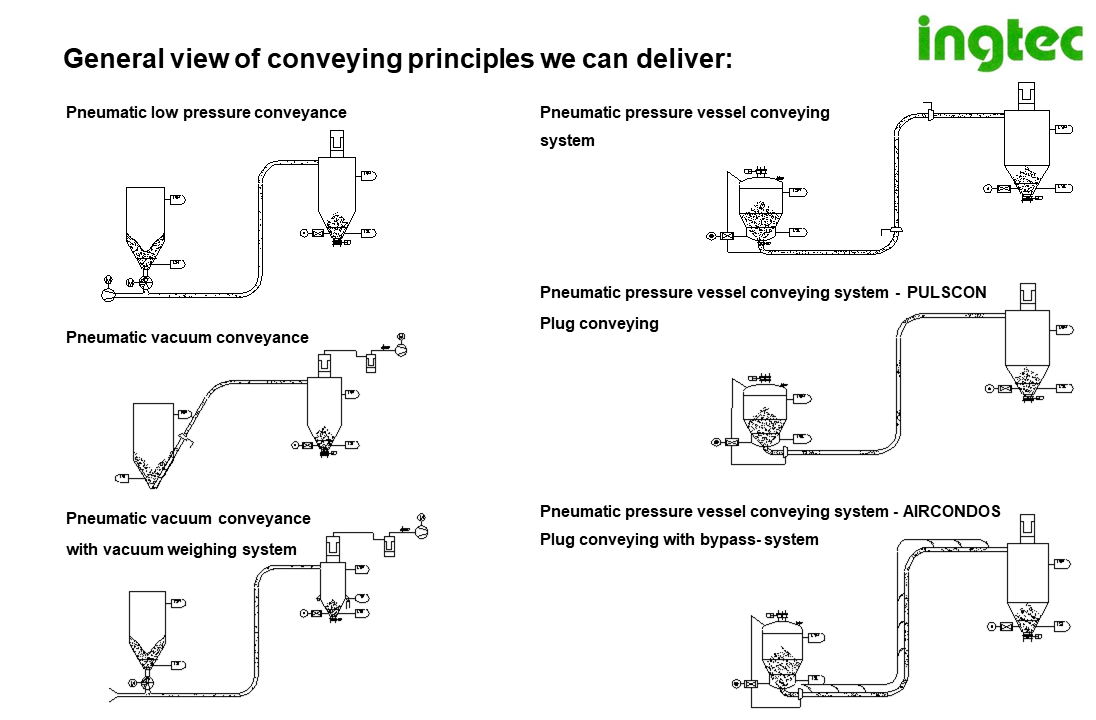
How Does Dilute-Phase Conveying Work?
Materials are conveyed either by vacuum, known as suction conveying, or by positive pressure, referred to as dilute-phase conveying.
Dilute-phase systems transport bulk and piece goods with low product loading and high flow velocities (approximately 20 to 30 m/s depending on the material and conveying distance) at low pressure.
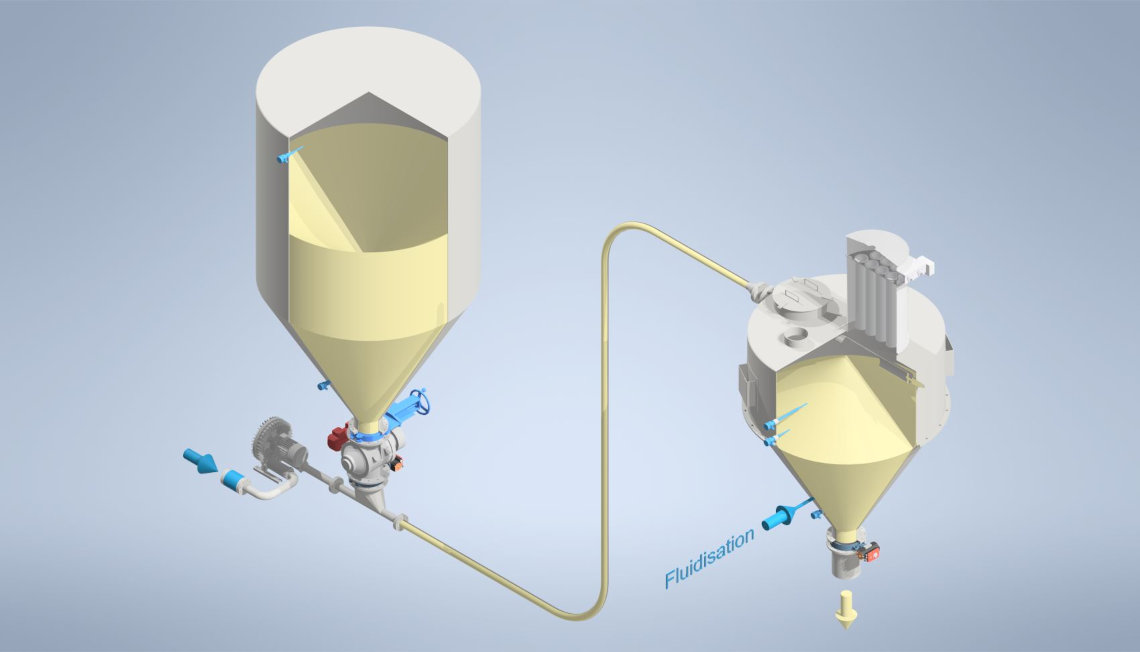
The speed within the pipeline must be high enough to prevent the material being conveyed from settling in the line.
To achieve this, the first step is to determine the suspension velocity of the material as well as the pressure loss during conveying, which is influenced by parameters such as pipeline length, diameter, and the number and shape of bends. Subsequently, the necessary volume of conveying air and conveying pressure can be calculated.
For generating compressed air, blowers, fans, side-channel compressors, or rotary lobe blowers are used.
The material is metered into the airstream via a feed shoe or a rotary valve.
In suction conveying, the fan/blower, along with the filter and police filter, is located at the end of the conveying process and generates the conveying flow using negative pressure.
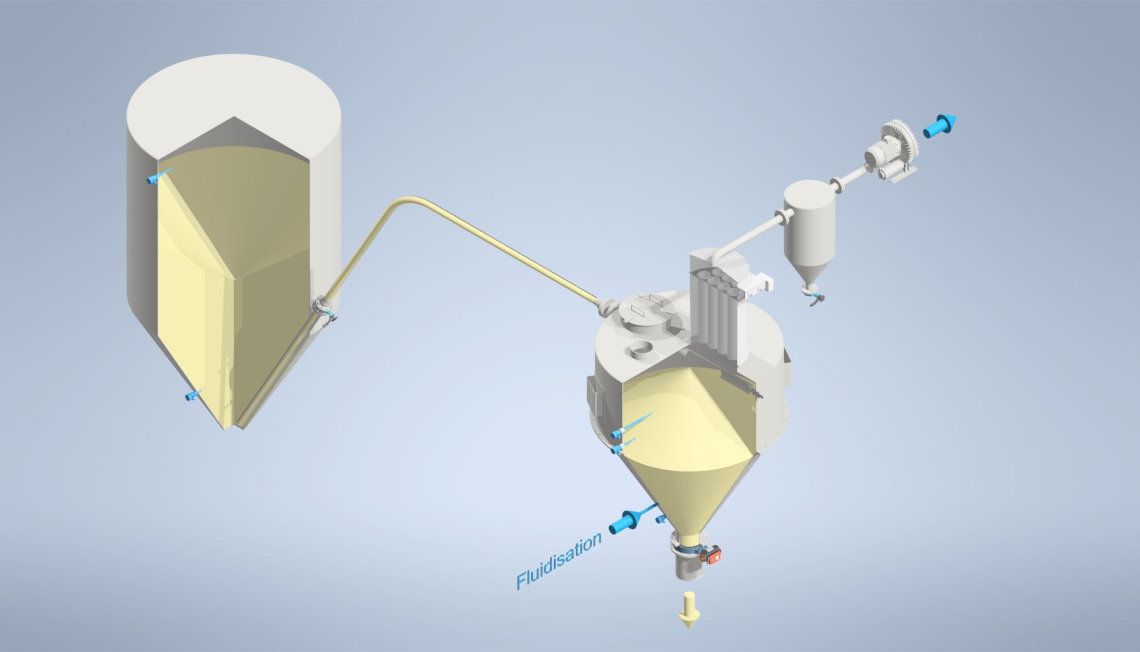
The product is introduced into the airflow via a suction lance, a feed shoe, or a rotary valve.
In pneumatic conveying, the conveying air is supplied to the airflow under positive pressure at the beginning.
This conveying method is primarily used for easily conveyable bulk materials and shorter distances than with positive pressure pneumatic conveying.
Summary:
- Pressure range up to approximately 0.8 bar by blower
- High conveying speeds of around 20 to 30 m/s
- Large volumes of air
- Low product charging mµ
- Not suitable for abrasive or difficult-to-convey products
Dense Phase Conveying
In dense phase conveying, a higher pressure is used compared to pneumatic conveying systems. This pressure is generated using compressors. The resulting advantages include higher product loading at lower conveying speeds.
The speed is adjustable. In this way, sensitive or abrasive products can be conveyed more gently.
Plug Conveying
By injecting air at a higher pressure than the conveying pressure, product plugs can be created in the conveying line, which move through the pipeline like a pneumatic tube system.
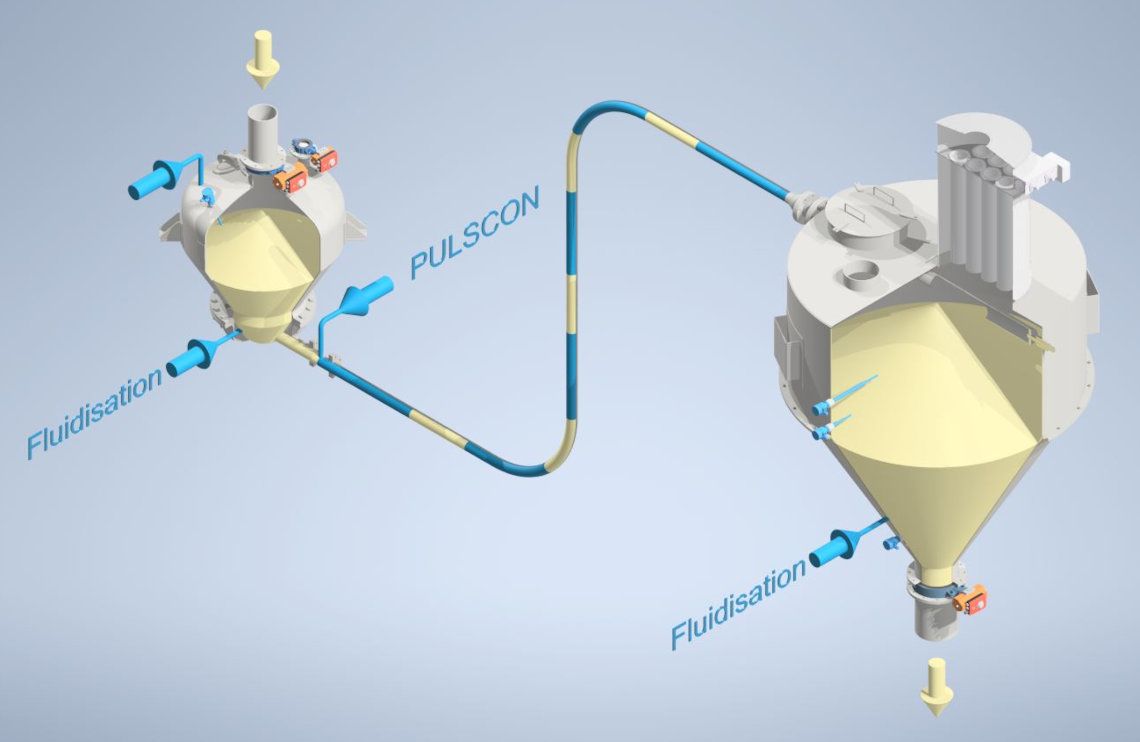
These plug conveying systems have been continually developed over the past decades, for example, through the use of blowers at exposed locations or bypass lines.
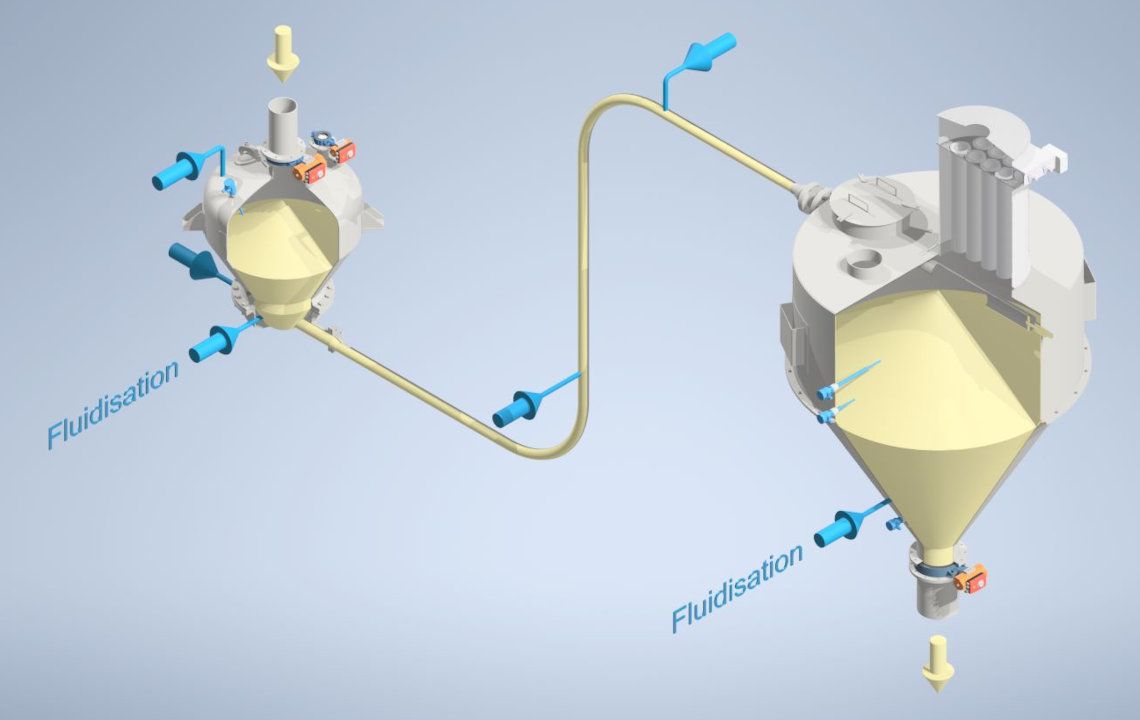
Bypass Conveying
A further development of existing bypass systems is the patented AIRCONDOS© bypass conveying system by Ingtec.

Bypass Conveying
The key difference compared to known dense phase conveying (push conveying) is that fluidizing and conveying air is dosed into the conveying line along the entire conveying route via a bypass line. The conveying speed can be kept nearly constant by expanding the pipe cross-sections.
By maintaining a supercritical pressure ratio, nearly sonic speed is generated in the gas dosing device. This ensures that a defined volume of air flows through each injection point (Laval nozzle) at all times, regardless of the conveying pressure. In this way, material plugs that form in the pipeline are consistently dissolved by the AIRCONDOS bypass system, ensuring flawless dense phase conveying.
The number and arrangement of injection points are custom-designed for each system. In this way, extremely difficult-to-flow products like TiO2 or lead dust can be conveyed without issues, while clogs or build-ups in the pipeline are avoided. Extremely abrasive products like corundum or silicon can be conveyed with low wear and tear due to low conveying speeds.
Difference from the standard bypass line:
Without the AIRCONDOS bypass system, there's a risk of pipeline clogging, as the injected air will follow the path of least resistance, meaning the air escapes through the free injection points of the standard bypass line.
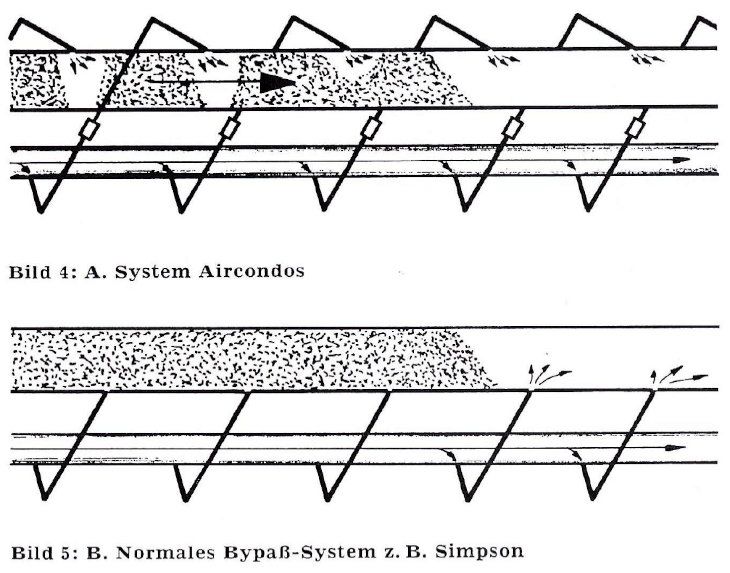
Summary:
- Low conveying speeds ranging from 0.5 to about 8m/s
- Abrasive products can be conveyed slowly
- Gentle conveying of sensitive products
- Reliable conveying of difficult-to-flow products
- No build-ups in the pipeline
- No clogs
- Starting with full pipelines is possible
- The line does not need to be emptied before operation
Which Conveying System is Suitable for Which Bulk Material?
In general, it can be said that light, free-flowing bulk materials such as plastic granules, wood pellets, or wood dust can be conveyed cost-effectively with pneumatic conveying systems.
For difficult-to-flow, caking, or abrasive bulk materials, a dense phase conveying system with a bypass system is suitable.
When designing a conveying system, many other factors must also be considered, such as conveying volume, length of the conveying line, number of bends, feed and discharge situations, as well as the combination with mechanical conveyors.
Storage and discharge from silos or receiving containers also play an important role for the trouble-free operation of an entire system. With the help of our fluidization technologies, which are also used in our pneumatic sending vessels, we can easily discharge difficult-to-flow or caking bulk materials like lead dust, titanium dioxide, or similar, thus ensuring quick emptying.
If you are facing issues with discharge, please do not hesitate to contact us. We are happy to advise you and develop suitable solutions for your problem.
Conclusion
The correct choice of conveying method is a crucial component for the trouble-free, low-maintenance, and cost-effective operation of your systems.
We are happy to assist you in making the selection and offer advice for solving your tasks. This applies to new installations as well as modernizations and expansions of existing systems.
We accompany you from the planning phase of the system, through the construction and commissioning stages, and also provide support for the maintenance of the systems.
For modernizations and expansions.
Frequently Asked Questions:
What bulk materials can you convey?
On this page, you can find a list of the bulk materials we have conveyed over the past decades.
Which products are suitable for dense phase conveying with the AIRCONDOS Bypass System?
- For abrasive products such as corundum, silicon, quartz sand, and more.
- For extremely difficult-to-flow bulk materials like titanium dioxide, wet fine sand, lead dust, color pigments, metal powder, soot, and more.
- For sensitive products like roasted coffee beans, perlite, cross-linkable polyethylene.
Can a full conveying line be restarted?
In general, a full conveying line cannot be restarted with pneumatic conveying.
However, with dense phase conveying using the AIRCONDOS Bypass System, a full conveying line can be restarted using the injection points.
Even for heavy bulk materials, such as lead dust with a bulk density of 2.2 kg/l or more, full conveying lines have been successfully restarted for demonstration purposes. The bypass system ensured safe emptying without the need to disassemble and clean the conveying line.
Is a pinch valve required after the sender?
The pneumatic senders from Ingtec AG are used for hard-flowing bulk materials and feature fluidizing beds and fluidizing strips in the sender's cone.
Thanks to the fluidization, the bulk materials become as flowable as water and do not require upstream pinch valves that need to be closed to pressurize the sender before conveying (which results in high wear and tear on the pinch valves).
What conveying systems does Ingtec AG offer?
We specialize in the following areas: Dense phase conveying system AIRCONDOS with bypass, plug conveying systems, pressure vessel conveying systems, dilute phase conveying in both vacuum and pressure systems, vacuum weighers, and regenerative conveying systems. If you have any questions, feel free to contact us by phone or email.
Manuel Hänggi studied mechanical engineering at BA Lörrach. The specialist in plant engineering and process technology has 20 years of experience in constructing plants. Since 2019, he has been leading the family business in its second generation.





